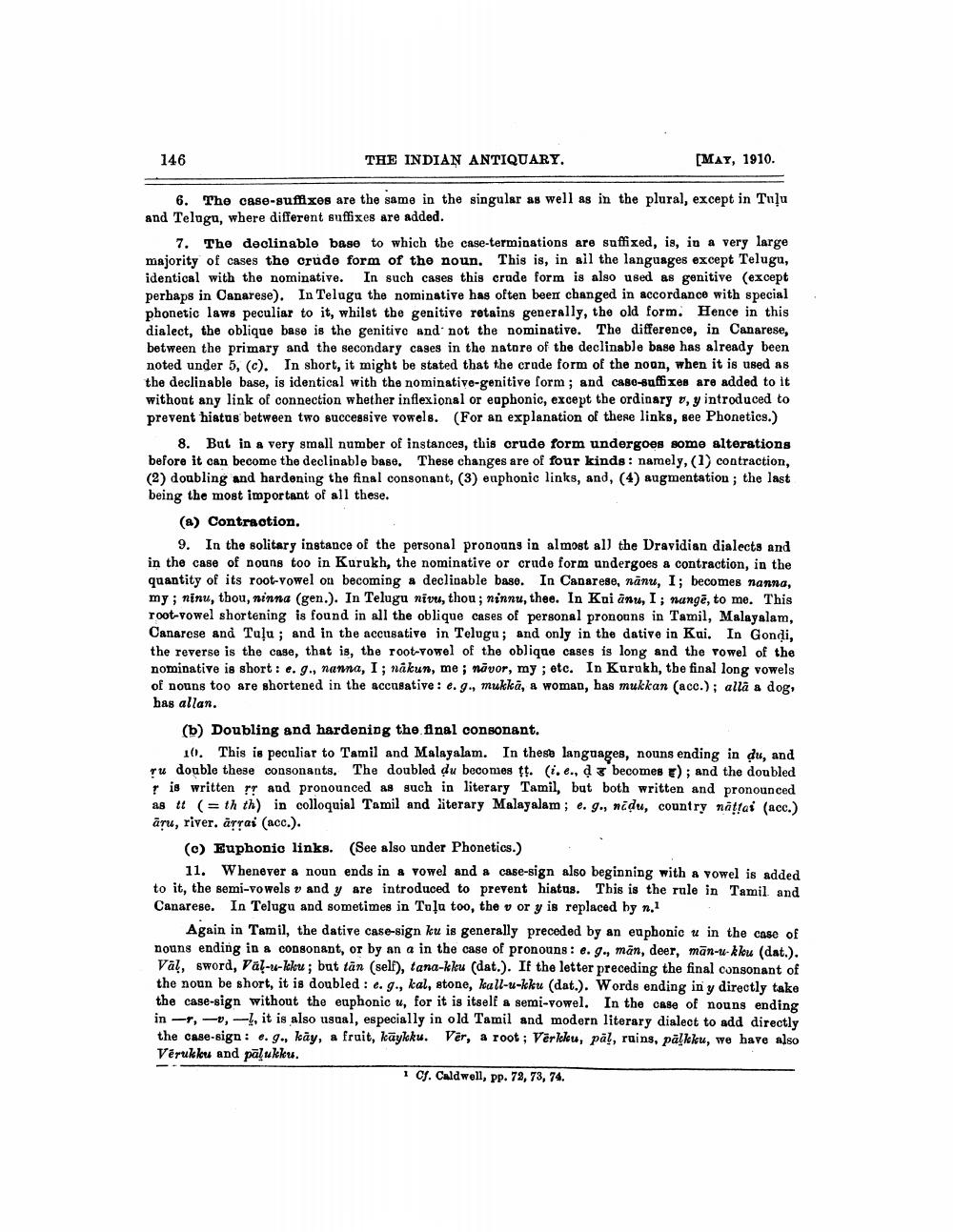________________
146
THE INDIAN ANTIQUARY.
[MAY, 1910.
6. The case-suffixes are the same in the singular as well as in the plural, except in Tuļu and Telugu, where different suffixes are added.
7. The declinable base to which the case-terminations are suffixed, is, in a very large majority of cases the crude form of the noun. This is, in ail the languages except Telugu, identical with the nominative. In such cases this crude form is also used as genitive (except perhaps in Canarese). In Telugu the nominative has often been changed in accordance with special phonetic laws peculiar to it, whilst the genitive retains generally, the old form. Hence in this dialect, the oblique base is the genitive and not the nominative. The difference, in Canarese, between the primary and the secondary cages in the natore of the declinable base has already been noted under 5, (c). In short, it might be stated that the crude form of the noon, when it is used as the declinable base, is identical with the nominative-genitive form; and cago-suffixes are added to it without any link of connection whether inflexional or eaphonic, except the ordinary y, y introduced to prevent hiatus between two successive vowels. (For an explanation of these links, see Phonetics.)
8. But in a very small number of instances, this crude form undergoes some alterations before it can become the declinable base. These changes are of four kinds: namely, (1) contraction, (2) doubling and hardening the final consonant, (3) euphonic links, and, (4) augmentation ; the last being the most important of all these.
(a) Contraction.
9. In the solitary instance of the personal pronouns in almost all the Dravidian dialects and in the case of nouns too in Kurukh, the nominative or crude form undergoes a contraction, in the quantity of its root-vowel on becoming a declinable base. In Canarese, nanu, I; becomes nanna, my; ninu, thou, ninna (gen.). In Telugu nivu, thou; ninnu, thee. In Kai anu, I; nangē, to me. This root-vowel shortening is found in all the oblique cases of personal pronouns in Tamil, Malayalam, Canarese and Tuļu; and in the accusative in Telugu; and only in the dative in Kui. In Gondi, the reverse is the case, that is, the root-vowel of the oblique cases is long and the towel of the nominative is short : e. g., nanna, I; nakun, me; nāvor, my ; etc. In Kurukh, the final long vowels of nouns too are shortened in the accusative: e... mukka, a woman, has mukkan (acc.); allă a dog, has allan.
(b) Doubling and hardening the final consonant.
10. This is peculiar to Tamil and Malayalam. In these languages, nouns ending in du, and ru double these consonants. The doubled du becomes tt. (i. e., d 3 becomes r); and the doubled r is written rr and pronounced as such in literary Tamil, but both written and pronounced as tt (=th th) in colloquial Tamil and literary Malayalam ; e. g., nidu, country nātrai (acc.) aru, river, arrai (acc.).
(c) Euphonic links. (See also under Phonetics.)
11. Whenever a noun ends in a vowel and a case-sign also beginning with a vowel is added to it, the semi-vowels v and y are introduced to prevent hiatus. This is the rule in Tamil and Canarese. In Telugu and sometimes in Tolu too, the v or y is replaced by n.1
Again in Tamil, the dative case-sign ku is generally preceded by an euphonic u in the case of nouns ending in a consonant, or by an a in the case of pronouns: e. g., mān, deer, mān-u-kkou (dat.). Val, sword, Val-u-kku; but tän (self), tana-kku (dat.). If the letter preceding the final consonant of the noun be short, it is doubled : e.g., kal, stone, kall-u-kku (dat.). Words ending in y directly take the case-sign without the euphonic u, for it is itself a semi-vowel. In the case of nouns ending in-,-,-, it is also usual, especially in old Tamil and modern literary dialect to add directly the case-sign: 6.9., kāy, a fruit, kāykku. Ver, a root; Vērieku, pal, ruins, palkku, we have also Vērukku and pāļukku.
1 Cf. Caldwell, pp. 72, 73, 74.




